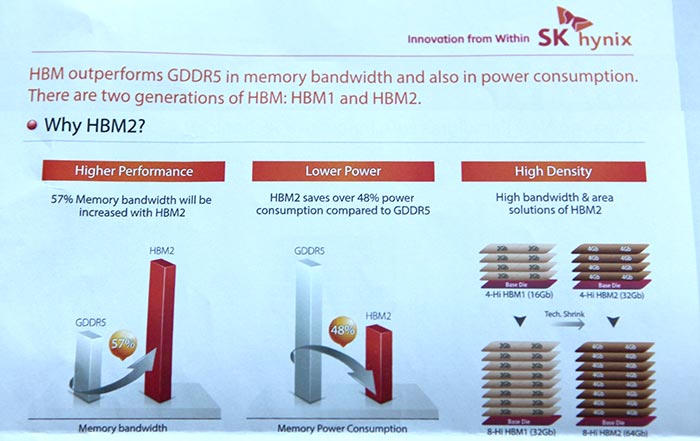One of the key technologies behind AMD's Radeon Fury range of graphics cards is the new type of memory known as High Bandwidth Memory, or HBM for short. The HEXUS editor wrote a full feature article about HBM back in May. First generation HBM chips run at a much lower clock speed to rival GDDR5 technology but offer a huge 1024-bit bus, with dense stacked RAM chips very close to the GPU, to provide much more bandwidth to the graphics system.
HBM single GPU graphics cards are restricted to a maximum of 4GB of video memory. With 4K gaming and beyond said to be 'where it's at' in the future this could be a stumbling block faced by adoptees in the coming months/years. However HBM designer and manufacturer SK Hynix already has already shown off plans for HBM2.

At the GPU Technology Conference in March this year HBM2 wafers were shown and its properties and capabilities discussed. With its greater densities the HBM2 memory architecture will allow graphics cards to be designed with up to 32GB of RAM on board.
A little earlier that month Nvidia unveiled the Nvidia GeForce GTX Titan X and sketched out details of its next gen Pascal GPU. According to Nvidia, sometime in 2016 we will see Pascal based graphics products featuring, among other things, 3D memory (with SK Hynix's HBM2 earmarked). Of course AMD isn't standing still and intends to make use of the next gen HBM2 in its Radeon Fury follow up flagship products. Then comes the crunch…

Apparently the first gen HBM has been in rather short supply. With the red and green graphics card goliaths hoping to facilitate mass production of competitive graphics cards based on HBM2 - it looks like there will be some kind of collision. However AMD might have the upper hand, if the sources speaking to WCCF Tech are correct. The tech site says that thanks to AMD's support for HBM and close, long standing working relationship with SK Hynix, it will get "Priority Access To HBM2 Production Capacity". Furthermore it will strive to capture "as much of the initial production capacity as possible," in a move that could stifle Nvidia's chances beyond a paper launch.
Whatever happens with the HBM2 allocation, the above scenario sounds like it will be a scrap worth watching.













